แนวทางการพัฒนาตำราเรียนภาษาเกาหลีในส่วนคำศัพท์ กรณีศึกษาผู้ศึกษาวิชาภาษาเกาหลีเพื่อการสื่อสาร I คณะมนุษยศาสตร์ มหาวิทยาลัยเกษตรศาสตร์
Main Article Content
บทคัดย่อ
งานวิจัยนี้มีวัตถุประสงค์เพื่อเสนอแนวทางในการพัฒนาตำราเรียนวิชาภาษาเกาหลีเพื่อการสื่อสาร I ในด้านคำศัพท์ โดยผู้วิจัยศึกษาความสัมพันธ์ของ “ความถูกต้องในการจดจำคำศัพท์และความหมาย” ร่วมกับ “สมมุติฐานที่เกี่ยวข้องกับการปรากฏของคำศัพท์และผลสัมฤทธิ์ในการจดจำคำศัพท์” ซึ่งแบ่งขั้นตอนการศึกษาวิจัยออกเป็น 2 ส่วนคือ 1) การศึกษาวิจัยเชิงปริมาณ และ 2) การศึกษาวิจัยเชิงคุณภาพ จากคำศัพท์ที่ปรากฏในตำราประกอบการสอนรายวิชาภาษาเกาหลีเพื่อการสื่อสาร I จำนวน 404 คำ โดยกลุ่มตัวอย่างที่ใช้ในการทดสอบคือ ผู้ศึกษาวิชาภาษาเกาหลีเพื่อการสื่อสาร I ที่ผ่านการอบรมตามหลักสูตรจำนวน 231 คน ภายหลังการเก็บข้อมูลผู้วิจัยใช้โปรแกรมเอสพีเอสเอสในการวิเคราะห์และสุรปข้อมูล สำหรับการศึกษาวิจัยเชิงคุณภาพ ผู้วิจัยเลือกคำศัพท์ที่มีค่าเฉลี่ยการจดจำสูงสุดและคำศัพท์ที่มีค่าเฉลี่ยการจดจำต่ำที่สุดมาวิเคราะห์การปรากฏในตำราเรียน เพื่อหาความสัมพันธ์ระหว่าง การปรากฏของคำศัพท์และผลสัมฤทธิ์ในการจดจำคำศัพท์ และผู้วิจัยยังศึกษาความถี่ในการปรากฏของคำศัพท์จาก “เนื้อหาในส่วนที่คำศัพท์เหล่านั้นปรากฏ” เพิ่มเติม ผลการวิเคราะห์พบว่า ความถี่ในการปรากฏของคำศัพท์จากตำรามิใช่ปัจจัยเพียงประการเดียวที่ส่งผลสัมฤทธิ์ต่อการจดจำคำศัพท์และความหมาย แต่เนื้อหาในส่วนที่คำศัพท์เหล่านั้นปรากฏก็เป็นอีกปัจจัยหนึ่งที่ส่งผลต่อผลสัมฤทธิ์ในการจดจำคำศัพท์และความหมายเช่นกัน จากนั้นผู้วิจัยนำผลการวิเคราะห์จากการศึกษาวิจัยเชิงปริมาณและการศึกษาเชิงคุณภาพมาเสนอเป็นแนวทางในการพัฒนาตำราภาษาเกาหลีโดยเฉพาะในส่วนของคำศัพท์ต่อไป
Article Details
เอกสารอ้างอิง
สมพงษ์ พันธุรัตน์. (2552). เอกสารประกอบการสอนรายวิขา 217720 ระเบียบวิจัยทางการศึกษา เรื่อง การประยุกต์ใช้คอมพิวเตอร์สำหรับวิเคราะห์ข้อมูลทางสถิติเพื่อการวิจัยทางการศึกษา. เว็บไซต์ https://home.kku.ac.th/sompo_pu/spweb/ เมื่อวันที่ 25 พฤษภาคม 2562 เวลา 21.30 น.
Uraiwan Jitpenthom Kim. (2017). การวิจัยเรื่อง “ข้อผิดพลาดในการใช้ปัจจัยเชื่อมแสดงเหตุผล ‘-아서’ และ ‘-니까’ (กรณีศึกษาของนิสิต เอกภาษาเกาหลี มหาวิทยาลัยบูรพา)”. หนังสือรวมบทความงานประชุมสัมมนาวิชาการ แนวทางการพัฒนาการเรียนการสอนภาษาเกาหลีระดับมัธยมศึกษาและอุดมศึกษา ประจำปี 2560, ปีที่ 1 เล่มที่ 1. หน้า 174-184.
BjÖrn Hammarberg. (2001). Roles of L1 and L2 in L3 production and acquisition, Cross-linguistic Influence in Third Language Acquisition: Psycholinguistic Perspectives. Bilingual Education and Bilingualism, Clevedon: Multilingual Matters. pp. 21-41.
D.A. Wilkind. (1972). Linguistics in language teaching. Great Britain: Richard Clay Ltd. p. 206.
H. DOUGLAS BROWN. (1980). Principles of Language Learning and Teaching. New Jersey: Englewood Cliffs. p.163-164.
Jaesu ChoiBoonrit Koheng. (2015). A research on the effects of English learning experience as L2 on Korean audio-morphological awareness as L3. Journal of Korean Language Education. Vol. 25 No. 2. pp. 239-258.
J. Kevin O’Regan and Arthur M. Jacobs. (1992). Optimal Viewing Position Effect in Word Recognition: A Challenge to Current Theory. Journal of Experimental Psychology: Human Perception and Performance, 18(1), 185-197.
Johannes C. Ziegler, A rthur M. Jacobs and Dorothee Klpüpel. (2001). Pseodohomophone Effect in Lexical Decision: Still a Challenge for Current Word Recognition Models. Journal of Experimental Psychology: Human Perception and Performance, 27(3), 547-559.
Melvin J. Yap and David A. Balota. (2009). Visual Word Recognition of Multisyllabic Words. Journal of Memory and Language, 60(4), 502-529.
공펭 소파. (2012).태국 고등학교 학습자를 위한 한국어 교재 개발 방안 연구. 고려대학교 대학원. 석사학위.
곽은경. (2018). 한국어 추측 표현 교육 방안 : 한국어태국어 대응 관계를 통해. 명지대학교 교육대학원. 석사학위.
김중섭. (2013). 한국어능력시험 초급 어휘 목록 개발 연구. 한국교육과정평가원.
Kesmanee Chutimon. (2013). 숙달도에 따른 태국인 학습자의 한국어 과거 관형사형 어미 사용 양상. 이화여자대학교 국제대학원. 석사학위.
분릿코헹. (2009). 한국어와 태국어 과거시제 대조 연구: ‘-었-’을 중심으로. 경희대학교 대학원. 석사학위.
SURIYANONRIN ORNJIRA. (2016). 태국 내 자기주도학습용 한국어 교재 대화문의 적절성에 관한 연구. 이화여자대학교 대학원. 석사학위.
CHUENGPREMPREE ARJAREE. (2013). 한•태 미래 표지에 대한 대조연구: ‘-겠-’, ‘-(으)ㄹ 것이-’, จะ ‘ca’를 중심으로. 이화여자대학교 대학원. 석사학위.
옹신 빤룻다. (2015).한국어와 태국어의 보조용언 체계 대조 연구 : “아/어 가다, 아/어 오다, 아/어 지다”를 중심으로. 경희대학교 일반대학원. 석사학위.
와이야티라프라놋. (2014). 한국어교육을 위한 타이어와 한국어의 시제 비교 연구. 청주대학교 대학원. 석사학위.
윤경원. (2009). 태국어의 언어적 특성을 기초로 한 태국인을 위한 효과적인 한국어 교육 교재의 적절한 방향성에 관한 연구. 한국외국어대학교 동남아연구소, 18호 2권. pp. 175-205.
이정희. (2005). 한국어 학습자의 오류 연구. 박이정. pp.131-295.
이준기. (2011). 관광 가이드를 위한 한국어 교재 개발 방안 연구. 한국언어문화교육학회, 2011호 1권. pp. 85-100.
인잔아농나르트. (2019). 한국 내 태국인 결혼이민자를 대상으로 하는 한국어 문법 오류 양상 및 교수•학습 방안 : 연결어미 ‘-아/어서-’를 중심으로. 상명대학교 대학원. 석사학위.
조아임이선웅. (2014). 한국어 초급 교재의 어휘 빈도와 어휘 반복 분석. 인문학연구, 97호. pp. 261-287.
지락사핌락. (2017). 태국인 학습자를 위한 비즈니스 한국어 교재 개발 연구. 한국외국어대학교 대학원. 석사학위.
짙시라판. (2014). 태국인 한국어 학습자의 연결어미 오류 연구. 상명대학교 일반대학원. 석사학위.
쭈타맛 분치. (2014). 한국어와 태국어의 시제 대조 연구. 충남대학교 대학원. 박사학위.
토트한 파나사. (2017). 태국 대학의 한국 문화 교재 분석 및 개발 연구. 한국외국어대학교 대학원. 석사학위.
팟차라야 빠라숫. (2013). 태국인 한국어 학습자의 계기 표현 교육에 대한 연구 : 연결어미 ‘-고’와 ‘-어서’를 중심으로. 연세대학교 대학원. 석사학위.
한주희. (2014). 한국어와 태국어 시간부사의 대조 연구. 충청문화연구, 13호. pp. 191-208.
한국어능력시험 토픽 어휘 목록 공개 목록. http://www.topik.go.kr/usr/cmm/subLocation.do? menuSeq=2110503
허용•김선정. (2006). 외국어로서의 한국어 발음 교육론. 박이정.
ตำราเรียนภาษาเกาหลี
국제교육원 한국어교육부. (2000). 경희대한국어 초급 1. 경희대학교출판부.
____________________________. (2001). 경희대한국어 초급 2. 경희대학교출판부.
서강대학교 한국어교육원. (2012). 서강한국어1 COMPACT SERIES. 서강대학교 국제문화교육원 출판부.
_____________________________. (2012). 서강한국어 2 COMPACT SERIES. 서강대학교 국제문화교육원 출판부.
서울대학교 언어교육원. (2013). 서울대한국어 1A. (주)투판즈.
이화여자대학교 언어교육원. (2015). 이화한국어 1-1. 이화여자대학교출판부.
__________________________________. (2015). 이화한국어 1-2. 이화여자대학교출판부.


